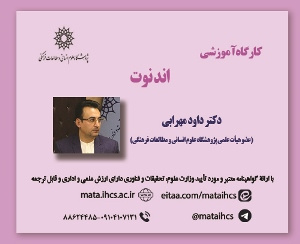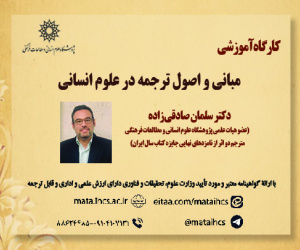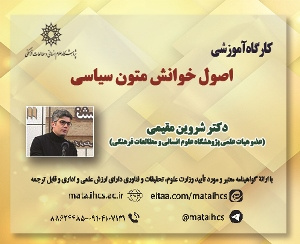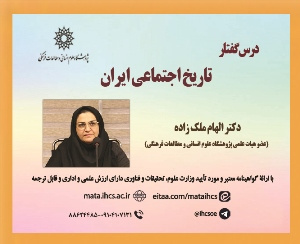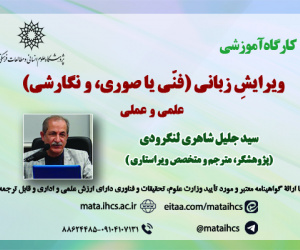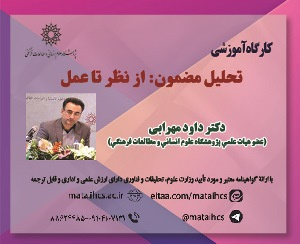ارزیابی مؤلفه های تأثیرگذار بر حضور پذیری زنان در فضاهای شهری، نمونه موردی بازار تاریخی ارومیه (مقاله علمی وزارت علوم)
درجه علمی: نشریه علمی (وزارت علوم)
آرشیو
چکیده
در طول تاریخ، جنسیت عامل مهمی در شکل گیری جایگاه فرد و به تبع آن ایفای نقش های متعدد او بوده است. همواره جوامع برحسب فرهنگ های متفاوت خود نقش های متفاوتی را به زن و مرد نسبت داده اند. به طوری که نقش مردان در شکل گیری فضاهای شهری بافاصله زیادی حائز اهمیت است با توجه به این که حداقل نیمی از شهروندان را زنان تشکیل می دهند، توجه به وجود فضاهایی برای حضور فعال هرچه بیشتر این قشر از جامعه در شهر حائز اهمیت می باشد. پژوهش حاضر ضمن بررسی وضعیت شاخص های مؤثر بر حضور پذیری زنان در فضاهای شهری نسبت به شناسایی مؤلفه های تأثیرگذار بر حضور زنان در بازارهای تاریخی می پردازد. بدین منظور "مجموعه بازار تاریخی شهر ارومیه " به عنوان یک فضای شهری در بافت تاریخی جهت مطالعه موردی انتخاب شد. با توجه به اینکه بازارها نقش محوری درمجموع فعالیت های شهری داشته؛ این سؤال مطرح است که چه عواملی در به وجود آمدن این مهم نقش اساسی دارد؟ نتایج به دست آمده حاکی از آن است که در حال حاضر علی رغم ظرفیت های متنوع در بحث حضور پذیری و همچنین ایجاد رضایت نسبی در برخی مؤلفه ها، بازار عملکرد مناسبی در خصوص حضور پذیری زنان نداشته و دچار مشکلات اساسی است. ازجمله مهم ترین چالش ها در این بحث عدم انطباق نیازها و مطالبات جامع زنان با زیرساخت های کاربردی، کالبدی و اجتماعی موجود بازاراست؛ به طوری که امکان حضور بخش عمده ای از زنان را فراهم نمی کند.Evaluation of the effective components of the presence of women in urban spaces: the case study a historical bazaar of Urmia
Throughout history, gender has been an important factor in the formation of a person's position and, accordingly, his multiple roles. Societies have always assigned different roles to men and women according to their different cultures. So the role of men in the formation of urban spaces is very important, considering that at least half of the citizens are women, it is important to pay attention to the existence of spaces for the active presence of this segment of society in the city. While examining the status of indicators affecting the presence of women in urban spaces, the present research deals with identifying the factors affecting the presence of women in historical markets. For this purpose, the "Historical Market Complex of Urmia City" was selected as an urban space in the historical context for the case study. Considering that markets play a central role in all urban activities; The question is, what factors play a major role in the emergence of this issue? The obtained results indicate that currently, despite the various capacities in the discussion of attendance and also relative satisfaction in some components, the market has not performed properly regarding the attendance of women and is suffering from fundamental problems. Among the most important challenges in this discussion is the non-compliance of the comprehensive needs and demands of women with the practical, physical and social infrastructures available in the market; So it does not allow the presence of a large part of women
Extended Abstract
Introduction
Public spaces in the life of urban residents are essential due to the use of these spaces is a significant part of their daily life in the city. In fact, these places are environments for cultural exchange, enjoyment, entertainment, leisure, social life, and the exchange of thoughts, views, and ideas. Throughout human history, gender has been an important factor in shaping the situation of the individual and consequently playing various roles. Societies have always assigned different roles to men and women according to their different cultures. Given that at least half of the citizens are women, it is important to pay attention to the existence of spaces for the active presence of this segment of society in the city. Since human societies are made up of men and women, addressing this part of society has a special place. The present study, while examining the conditions of indicators affecting the presence of women in urban spaces, identifies the effective components of women’s presence in historical bazaars. The historical bazaar of Urmia is considered one of the most dynamic and essential urban spaces of Urmia, which has been able to continue its life despite all the changes in the city. This complex, like many traditional bazaars in Iran, in addition to its economic function, is also a carrier for many social and cultural activities. The issue of women's presence in historical bazaars is significant, so paying attention to its issues and problems and planning to remove obstacles in this regard is inevitable. In this regard, the "Historical Bazaar Complex of Urmia" was selected as an urban space in the historical context for the case study. This complex consists of various physical architectural spaces that actualize the major needs of society. At present, this space, as the most important urban space, has lost its ability to attract different kinds of women, and what is clear is that the number of women referring to the historical bazaar has changed significantly. Considering the proposed hypothesis, the purpose of this study was to investigate and explain the reasons for the decrease in satisfaction and the presence of different segments of women in the historical bazaar of Urmia and in this regard, it has studied the effective factors of the women’s presence concept. This article seeks to answer that; what factors play a key role in creating this important? What was the presence of different sexual-age groups of women compared to men? And what is the impact of this issue in relation to the components and criteria of the concept of attendance?
Although the factors affecting the presence of women in urban spaces have been proposed in many types of research, there has been no independent research on the topic of the presence of women in historical bazaars, especially concerning the historical bazaar of Urmia city, in terms of the detailed design of different spaces, including the lines and entrances. Therefore, conducting this research can be a breakthrough in this regard.
Methodology
The current research method is applied-developmental, which has prepared and compiled the conceptual framework of the research by using the descriptive and analytical approach to investigate the presence of women in the historical bazaar of Urmia. The library and document information was collected using quantitative statistical methods and SPSS software. In this research, information was obtained through the field method and based on a questionnaire that was distributed among four age groups of women in a cluster. In this part of the research, a five-point Likert-Scale method was used in preparing the questionnaire. The statistical population of this research includes the number of women visiting the bazaar in a full working day (10 am to 8 pm) in the historical bazaar of Urmia in the summer of 2022. Since the number of women visiting the historical bazaar of Urmia is an unlimited community, by using the method of counting the number of women entering the bazaar from different entrances at different hours, the size of the statistical population is 2482 people, which is 142 people were determined from Cochran's sample size estimation method.
These questionnaires were randomly distributed among people at different hours of the day and night. In order to measure the reliability of the questionnaire, Cronbach's alpha was calculated for the questions. The value of Cronbach's alpha obtained is 0.754, which is at the desired level.
Results and discussion
Based on statistical studies and calculations among different age groups of women, the presence of married women is higher than single women. Considering the employment conditions, the number of referrals of working women shows a higher number than housewives. Among the other research findings are the presence of more women in the four cities of Urmia compared to other urban areas and the frequency of visits by women in the age range of 36 to 50 years. Also, the number of women visiting the historical bazaar of Urmia is less than that of men. This survey showed that women visit the bazaar more in the evening, and the entrance leading to the Zargaran area has the most women. In order to measure the willingness of women to refer to the historical bazaar as well as the changes aimed at improving the bazaar situation, the obtained results indicate that women have a great desire to refer to and make changes to increase attendance.
The conducted investigations reveal that the historical bazaar, despite having acceptable conditions in relation to the physical and social component, has not been able to meet the needs of the majority of other age groups of women, so it is not attractive enough, especially for younger women with high education, in this regard, the requirements of the component physical and social effects are also effective. Going to the bazaar daily is another characteristic of the historical bazaar, which keeps the bazaar in the flow of daily life.
Conclusion
According to the collected information and the summaries, it was found that the most dissatisfaction was related to the user component and then the physical component of the complex, and the social component was ranked third. Hence, the Urmia bazaar, concerning the social component in comparison, has better conditions than other components. In general, while confirming the hypothesis of the research, Urmia's historic bazaar complex, despite its various capacities in the discussion of attendance and creating relative satisfaction in some components, needs to perform properly in terms of attendance and is suffering from fundamental problems. Among the most important challenges in this discussion is the non-compliance of women's comprehensive needs and demands with the existing infrastructure; it does not allow the presence of a large part of women. According to the purpose of the research, the present research has only studied and examined the problems and issues that different classes of women faced in the historical bazaar, so providing solutions and suggestions to remove obstacles in the bazaar requires independent research.
Funding
There is no funding support.
Authors’ Contribution
All of the authors approved thecontent of the manuscript and agreed on all aspects of the work.
Conflict of Interest
Authors declared no conflict of interest.
Acknowledgments
We are grateful to all the scientific consultants of this paper.
